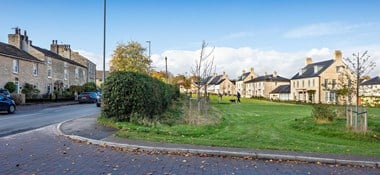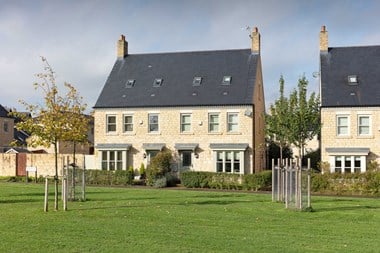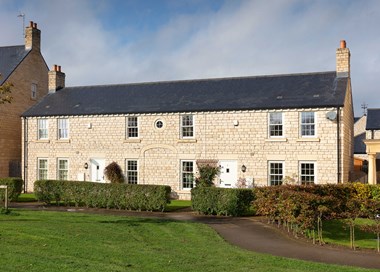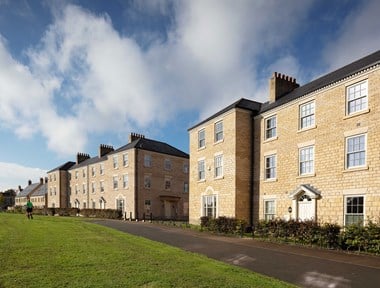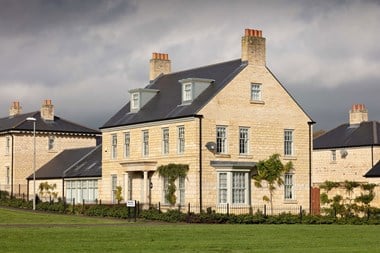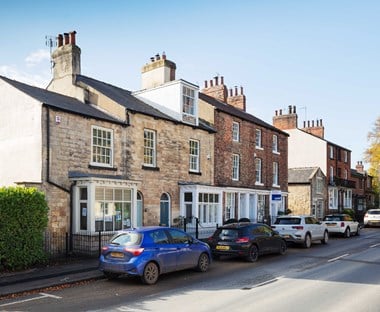Design Case Study Church Fields, Boston Spa, West Yorkshire
Residential extension to the edge of an historic village, reinterpreting traditional architectural forms to create a strong sense of place and a high quality of public spaces.
This case study is one of ten studies of new residential or mixed-use developments compiled in 2020 by Purcell on behalf of Historic England.
Project information
- Region: Yorkshire
- Location and postcode: Boston Spa, Wetherby, LS23
- Local planning authority: Leeds City Council
- Architects: John R Paley Associates
- Developer / land owner: Taylor Wimpey
- Number of residential units: 170
- Other uses: None
- Awards: Housing Design Awards, 2013; Building For Life 12 ‘Built For Life’ status, 2013
Description of development
Church Fields is an eight-hectare site within the conservation area of Boston Spa. It occupies a broad swathe of land at the west end of the village, lying between the High Street on the south side and the River Wharfe to the north. It replaces an area of hutments built as accommodation for munitions workers at the nearby Thorp Arch factory during the Second World War.
The development provides a wide range of different house types, ranging in size from two-bedroom to five-bedroom properties, and incorporating a proportion of affordable housing. The housing is a mixture of two and three storeys in height, some terraced and some detached. Whilst a variety of vernacular architectural forms and features are employed, the use of natural stone for all external walling ensures a degree of consistency and continuity with the nearby village houses.
There are three hectares of public open space, both formal and informal, including a large green between the new houses and St Mary’s Church to the south east. There is also a broad space along the northern edge of the development which provides an attractive green buffer space between the housing the River Wharfe. Each house is provided with a small courtyard or garden as a private open space surrounded by fences. The masterplan incorporates a number of pedestrian routes through the site and ensures that the roads are pedestrian-friendly.
Heritage assets affected
Boston Spa is a linear village located between Wetherby and Tadcaster, founded as a small spa resort in the mid-18th century. Its built environment is of extremely high quality, a fact which is demonstrated by the high density of listed buildings in the village. Boston Spa is unusual in that it developed rapidly over a short space of time, with the majority of buildings in the historic core built between 1770 and 1830. Boston Spa Conservation Area covers part of the site. The development site is within the setting of the Church of St Mary the Virgin, which in its present form dates largely from the 1870s. The church is listed at Grade II. Along the south side of the High Street, facing Church Fields, are numerous stone-built village houses, several of which are listed at Grade II.
Planning context
The development was the subject of two applications on this allocated housing site, both of which were refused by Leeds City Council. Following appeals and a public inquiry in 2011, planning permission was granted by the Planning Inspectorate for both Scheme A (170 homes) and Scheme B (153 homes).
During the consultation process, conservation comments were received from English Heritage (now Historic England) which stated that ‘we are satisfied that the proposal in its current form would meet our primary requirement of reinforcing local distinctiveness’ and ‘the house types and layout have been developed using local vernacular detailing, based on an assessment of the landscape setting and historical development of the village’.
Assessment of design qualities and relationship to historic environment
The architects undertook a series of site visits to develop an understanding of the site, its context and the built fabric and structure of Boston Spa. The information gathered by these sites visits was augmented with historical research into the evolution of the town over the past 250 years and combined with experience gained on smaller projects within the immediate geographical area.
The road layout is designed to create changing vistas within the scheme and has sharp turns which help to slow traffic speeds. The scale and disposition of houses is irregular, helping to create a sense of informality which mirrors the varied arrangement and juxtapositions of older houses on the opposite side of High Street.
The individual house designs adapt a variety of Georgian architectural forms, including terraces, mews houses and detached villas, all with timber sash windows and slate-covered roofs. External walls are faced with the pale cream-coloured magnesian limestone which is the prevailing walling material for the older houses in the village. The overall design approach is therefore closely related to the architectural forms and materials found elsewhere in the Conservation Area, although with a certain freedom in adapting them to suit present-day requirements.
The layout takes full advantage of views across a broad green space views towards the listed church and across the River Wharfe to rural views beyond the village. There is generous provision of open space, with existing trees retained and new trees added.
The Inspector, in granting approval for the scheme at appeal, commented that the proposals ‘would respond to and, to an extent, reinforce the existing character of this area’ and ‘the proposed streets and new frontages would be in keeping with the existing street scene and pattern in older Boston Spa’.
He also commented that ‘the proposed dwelling types are individually well proportioned and generally in character with the range of older buildings elsewhere within the Conservation Area’.
Key points
The scheme’s character reflects the historic vernacular architecture and use of materials in Boston Spa, invoking a sense of place through the composition of spaces between buildings, their heights, textures, forms and solidity. Without direct imitation, the houses reflect the forms and details of traditional buildings in the neighbourhood, combining formal and informal terraces, and courtyard forms.
In the masterplan of the development, there is a clear hierarchy of circulation in the site, with pedestrian routes connecting the riverbank with the High Street in various ways and connecting well with each unit of the neighbourhood. At the perimeter of the scheme, houses face outwards across green frontages – towards the river bank on the north boundary, towards the listed church on the east side of the site and towards historic village buildings across the High Street to the south. The development incorporates several public open spaces and takes advantage of existing trees to create a harmonious green landscape setting.
Views of Church Fields, Boston Spa
Please click on the gallery images to enlarge.
-
Design in the Historic Environment
Principles and case studies for good practice in design when making changes to the built historic environment.
-
Design in the Historic Environment: Case Studies
Download all ten case studies as a PDF document.
-
Design Case Study: Roussillon Park Chichester, West Sussex
A case study of design in the historic environment: Roussillion Park is a modern residential complex at the site of a former barracks in Chichester.
-
Wildernesse House Mews, Sevenoaks
Case study of a new mews-style development within the setting of a Grade II listed mansion and within an area of historic landscape.
-
Bourne Estate, Holborn, London
An award-winning residential extension on a Grade II listed urban estate, bringing together old and new through quality detailing and landscaping.
-
Design Case Study: 168 Upper Street, Islington
A case study of an imaginative reinstatement of a missing corner building in Islington that reproduces the original facade.
-
Temple Gardens, Temple Cloud
Design case study of the refurbishment and viable reuse of a listed pub, with a sensitive scheme of new housing and hotel development.
-
Fairmile Hospital
Case study of the re-development of a former hospital on the edge of a rural village with new homes designed as distinctive groups.
-
Garden Quarter, Caversfield
Case study for design in the historic environment of the sensitive redevelopment of a former Royal Air force site into a residential community.
-
Timekeepers Square, Salford
Case study of a redevelopment that recreates the vernacular Georgian terrace and urban grain within the setting of a listed church.
-
Welsh Streets Liverpool 8
Case study of an ambitious and popular scheme that converts hundreds of derelict Victorian terraced houses.


